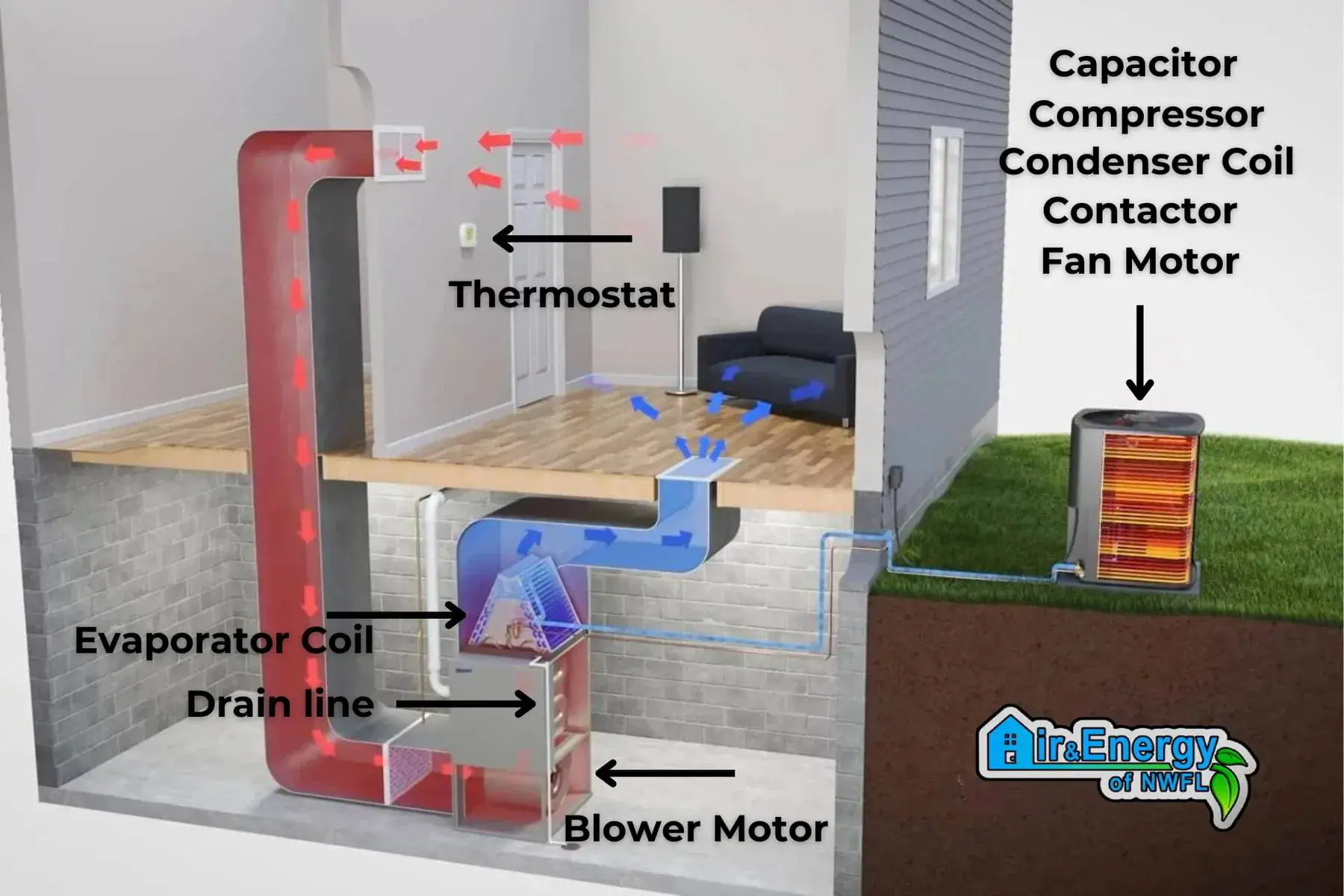Ever noticed your own AC system struggling to keep up on a hot day? Or maybe your heater isn’t warming your home like it used to? Before calling in a pro, a simple DIY HVAC inspection can help you catch small issues before they turn into costly repairs. Regular HVAC maintenance improves efficiency, extends system life, and saves money on energy bills.
This guide walks you through a step-by-step HVAC inspection checklist, showing you what to check and when it’s time to bring in a professional. Let’s get started—keeping your home comfortable might be easier than you think!
Why Regular HVAC Inspections Matter
The Benefits of DIY HVAC Inspections
A DIY HVAC inspection saves money and prevents headaches. Catching small issues early—like a clogged filter or loose ductwork—helps avoid costly repairs. Routine checks boost efficiency, keeping your system running smoothly while lowering energy bills.
Here’s why regular DIY HVAC home inspections really are worth your time:
- Cost savings – Identifying small issues (like a dirty air filter) prevents expensive emergency repairs.
- Preventative maintenance – Catching problems early reduces the risk of major breakdowns.
- Energy efficiency improvements – A well-maintained system runs more efficiently and lowers monthly energy bills.
- Extending system lifespan – Reducing wear and tear helps avoid premature HVAC replacements.
For example, if your air conditioner is blowing weak air, a quick filter replacement might restore its performance—without needing a costly service call. By taking a few proactive steps, you can keep your home comfortable and your HVAC system in top shape.
When to Schedule an HVAC Inspection
Knowing when to inspect your HVAC system can help you avoid breakdowns and costly repairs.
Here are the best times to perform a DIY check:
- Seasonal changes – Inspect your system in spring and fall to ensure it’s ready for extreme temperatures.
- Before buying or selling a home – A thorough inspection helps assess system health and efficiency.
- When you notice performance issues – Weak airflow, unusual noises, inconsistent temperatures, or rising energy bills signal it’s time for a check.
Regular inspections keep your system running smoothly and help spot problems before they become expensive repairs. Understanding the HVAC inspection cost is crucial, as it highlights typical price ranges and factors influencing those costs.
Regular professional HVAC inspections can save money in the long run and help make informed decisions during home purchases.
DIY HVAC Inspection Checklist
A quick home HVAC check can prevent expensive repairs. Inspecting your own heating, ventilation, and air conditioning system is crucial for ensuring efficient operation, safety, and longevity. Follow these step-by-step checks to ensure your system is running efficiently.
Step 1: Check the Thermostat
The thermostat controls your entire HVAC system, so a malfunctioning unit can mimic a system failure. Here’s what to check:
🔧 Tools Needed: None (except batteries for replacement)
✅ Quick Assessment:
- Set the thermostat to different modes (heat, cool, fan, auto) and check if it responds correctly.
- Compare the displayed temperature with an external thermometer to ensure accuracy.
- Replace the batteries if the screen is dim or unresponsive.
- For smart thermostats, test WiFi connectivity and ensure it’s properly synced with your HVAC system.
⚠️ Potential Issues:
- If no response when switching modes → Possible wiring issue, faulty thermostat, or faulty electrical connections.
- If the temperature readings are inaccurate → Calibration may be needed.
- If the thermostat turns off unexpectedly, → Weak batteries, electrical issues, or faulty electrical connections.
Quick Fix: A simple battery swap or recalibration can resolve many thermostat-related HVAC issues.
Step 2: Inspect the Air Filters
A dirty air filter is one of the most common reasons for HVAC inefficiency.
🔧 Tools Needed: None (except replacement filter if needed)
✅ Quick Assessment:
- Locate your air filter (commonly found near the return air duct, blower compartment, or ceiling vent).
- Remove the filter and hold it up to the light—if light doesn’t pass through, it’s too dirty.
- Check for visible dust buildup, pet hair, or discoloration.
⚠️ Potential Issues:
- Clogged filter → Reduces airflow, causing your system to work harder and increase energy bills.
- Dusty vents or rooms → Indicates an overdue filter change.
- Unusual smells → A filter clogged with mold, dust, or allergens can degrade indoor air quality.
Quick Fix: Replace every 1-3 months, depending on usage and household conditions.
Step 3: Examine the Outdoor Unit (AC Condenser)
Your AC condenser is exposed to the elements, making it prone to dirt buildup and obstructions.
🔧 Tools Needed: Garden hose, soft brush, screwdriver (for panel removal if needed)
✅ Quick Assessment:
- Remove leaves, dirt, and debris around the unit. Keep at least 2 feet of clearance.
- Inspect the condenser fins—if they are bent, use a fin comb or gently straighten them.
- Look for signs of rust, leaks, or corrosion on the unit casing and refrigerant lines.
- Ensure the unit is level—uneven placement can strain the compressor.
⚠️ Potential Issues:
- Blocked condenser → Reduced cooling efficiency and higher energy consumption.
- Bent or dirty fins → Restricts airflow, forcing the system to work harder.
- Rust or refrigerant leaks → Can indicate aging components that may need professional attention.
Quick Fix: Regularly clean debris and straighten fins to maintain airflow.
Step 4: Inspect the Furnace & Heat Exchanger
A faulty furnace or heat exchanger can lead to inefficient heating—or worse, dangerous carbon monoxide leaks. A well-maintained system runs smoother and lasts longer.
🔧 Tools Needed: Flashlight, screwdriver (if panel removal is needed)
✅ Quick Assessment:
- Open the furnace panel and inspect for cracks, rust, or soot buildup.
- Check the pilot light (for gas furnaces)—it should be a steady blue flame.
- Listen for banging, rattling, or whistling sounds when the furnace is running.
- Smell for burning odors or gas leaks—if you smell gas, turn off the system and call a pro.
⚠️ Potential Issues:
- Cracks or rust in the heat exchanger → Potential carbon monoxide leak, requires immediate attention.
- Yellow or flickering pilot light → Could indicate incomplete combustion or a gas issue.
- Unusual noises → Might signal a loose part, dirty burner, or ignition problem.
Quick Fix: Clean minor soot buildup, but if you suspect cracks or gas leaks, call a professional immediately.
Step 5: Assess Ductwork & Vents
Your ductwork and vents control airflow—leaks, blockages, or disconnections reduce efficiency. Regularly check for dust buildup, loose connections, and restricted airflow to maintain consistent home comfort.
🔧 Tools Needed: Flashlight, screwdriver (for duct cover removal if necessary)
✅ Quick Assessment:
- Look for dust buildup or blockages in supply and return vents.
- Ensure all air vents are fully open for balanced airflow.
- Inspect visible ductwork for gaps, disconnected sections, or air leaks.
- Note if some rooms feel hotter or colder than others, which may indicate airflow problems.
⚠️ Potential Issues:
- Blocked vents → Reduces system efficiency and causes uneven heating/cooling.
- Leaky ducts → Can waste energy and reduce system performance.
- Dusty ducts → May indicate excessive debris buildup affecting air quality.
- Quick Fix: Vacuum visible dust from vents and use metal duct tape (not regular tape) to seal minor leaks.
Step 6: Check and Clean the Condensate Drain
A clogged condensate drain can cause water leaks, mold growth, and reduced HVAC efficiency. Over time, dirt, algae, and debris can build up, blocking the drain line and leading to system issues.
🔧 Tools Needed:
- A wet/dry vacuum or a long flexible brush
- A cup of white vinegar or warm soapy water
- A small funnel or squeeze bottle
✅ Quick Assessment:
- Locate the condensate drain line (usually a PVC pipe near the indoor unit).
- Check for standing water or visible clogs in the drain pan.
- Inspect the drain outlet outside your home to ensure water is flowing freely.
⚠️ Potential Issues:
- Water pooling around the indoor unit → Indicates a clogged drain line.
- Musty odors near vents → Could be mold or algae buildup in the drain system.
- HVAC shutting off unexpectedly → Some systems have a safety switch that turns off the unit when the drain is clogged.
Quick Fix:
- Flush the drain line with a cup of white vinegar to dissolve algae and buildup.
- Use a wet/dry vacuum at the drain outlet outside to suck out blockages.
- If the clog is severe, insert a thin brush or flexible wire to clear debris.
📌 Pro Tip: To prevent future clogs, pour a cup of vinegar or warm soapy water down the drain every 2-3 months.
By following this DIY HVAC inspection checklist, you can identify minor issues early, improve system efficiency, and avoid unnecessary repair costs. However, if you notice major issues like gas leaks, refrigerant leaks, or persistent mechanical failures, it’s time to call a professional HVAC inspector.
Signs You Need a Pro
While a DIY HVAC inspection can resolve minor issues, some problems require a licensed professional. Even if your HVAC system seems fine, regular maintenance keeps it that way.
Here are simple steps to avoid future breakdowns.
- Persistent airflow issues – If vents still blow weak or uneven air after cleaning filters and checking ducts, there may be a blower motor or duct leak issue.
- Unresponsive thermostat – If replacing batteries and recalibrating doesn’t help, the problem could be faulty wiring or a failing control board.
- Electrical issues – Frequent circuit breaker trips when the HVAC runs may indicate overloaded wiring or a failing compressor—a fire hazard.
- Gas smells or refrigerant leaks – A rotten egg odor (natural gas) or a chemical smell (refrigerant) are dangerous and require immediate professional assistance.
- Strange noises persist – Grinding, screeching, or banging sounds could mean worn-out components that need replacement.
Ignoring these signs can lead to costly repairs and safety risks—schedule an HVAC service ASAP if any apply.
Preventative Maintenance Tips
Even if your HVAC system seems fine, regular maintenance keeps it that way.
Here are simple steps to avoid future breakdowns.
- Set seasonal reminders – Inspect your HVAC system every spring and fall to prepare for temperature shifts.
- Keep the outdoor unit clear – Maintain at least 2 feet of clearance around the AC condenser by removing leaves, dirt, and debris.
- Schedule professional tune-ups annually – A licensed technician can clean coils, check refrigerant levels, and ensure peak efficiency.
- Monitor energy bills – Sudden spikes in utility costs can signal a struggling system, clogged filters, or duct leaks.
- Change air filters regularly – Replace filters every 1-3 months to improve airflow and indoor air quality.
A little maintenance now saves big repair costs later.
Conclusion
Performing a DIY HVAC inspection helps prevent costly repairs, improve efficiency, and extend the lifespan of your system. Regularly checking your thermostat, air filters, outdoor unit, furnace, ductwork, and vents can catch minor issues before they become major problems. Routine maintenance keeps your HVAC running efficiently, lowering energy bills and enhancing home comfort.
However, if you notice persistent airflow issues, gas smells, electrical problems, or refrigerant leaks, it’s time to call a professional. For homeowners in Pensacola and the surrounding areas, trust Air & Energy of NWFL to keep your HVAC system running at its best. Contact us today for expert service!
This article was written by:
Co-founder and Home Comfort Specialist




